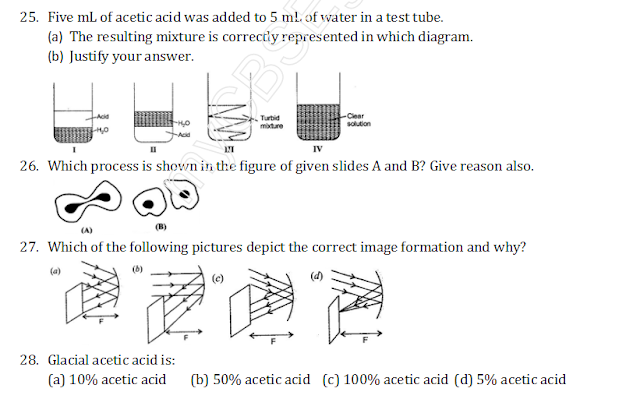CBSE Sample Paper-02
SUMMATIVE ASSESSMENT –II
SCIENCE (Theory)
Class – X
1. What is acid rain?
2. Name the product formed beside soap that is obtained during saponification process.
3. Are the laws of reflection applicable to plane surf aces also valid for curved surfaces?
4. In what S.I. unit is power of lenses rated? A conve x lens has a focal length of 50 cm, Calculate its power.
5. How does the metallic character change along the period?
6. Name one organ analogous to the wing of the bird. W hy are they both analogous? Can you include the wing of bat also with them under the sa me category? Give reason.
7. What is accommodation? Explain how does the ciliary muscles do help in accommodation?
8. What is persistence of vision? How do we make a mot ion picture possible?
9. Why are the some substances biodegradable and some non-biodegradable?
10. Write the cause of depletion of ozone layer in the atmosphere.
11. What are homologous organs? How do they provide evi dence in support of evolution?
12. Explain how a new species is generated.
13. Define Mendeleev’s Periodic Law. Give two advantage s of Mendeleev’s Periodic Table.
14. Why was it necessary to change the basis of classif ication from atomic mass to atomic number.
15. How does binary fission differ from multiple fissio n?
16. Explain double fertilization in plants.
17. Ramesh and his friends performed well in SA-1. They wanted to go for outing, so they made a request to the principal in this regard. It was dec ided that they will go by cycle to witness the famous Ranapur water fountain show, situated nearly eight kilometers from their place, with their physical education teacher. It was sunny day. They all enjoyed, rejuvenated and rejoiced mind and body. Ramesh was thrilled as he saw an exciting natural spectrum app earing in the sky when he looked at the sky through the water fountain, with the sum behind him . He came back with a number of questions in his mind.
Read the given passage and answer the following que stions: (a) Name the natural spectrum appearing in the sky. How does it form?
(b) Draw a ray diagram showing formation of natural spe ctrum appearing in the sky.
(c) What value of shown by Ramesh
18. An object 3 cm high is placed perpendicular to the principal axis of a concave lens of focal length 15 cm. The image is formed at a distance of 10 cm from the lens. Calculate:
(a) Distance at which the object is placed.
(b) Size and nature of the image formed.
19. Discuss in brief the various modes of reproduction used by single organisms.
Or Explain with example how characteristics of a popul ation changes over the years for the following situations:
(a) To gain survival advantage.
(b) Due to accidental survival.
(c) Temporary change of characteristics.
20. A convex lens has a focal length of 10 cm. At what distance from the lens should the object be placed so that it forms a real and inverted image 2 0 cm. away from the lens? What would be the size of the image formed if the object is 2 cm high? With the help of a ray diagram show the formation of the image by the lens in this case?
Or (i) Define: (a) Centre of curvature (b) Pole of a concave mirror
(ii) State the mirror formula and its magnificatio n.
(iii) Using the same find the distance at which an object to be placed for getting a real, inverted enlarged image at 45 cm using a concave mirror of f ocal length 20 cm.
21. Draw a labelled diagram which shows the refraction of light through a triangular glass prism.
Mark the: (i) Angle of deviation
(ii) Angle of emergence
(ii i) Angle of prism
Or
Give some points of similarities and dissimilaritie s between a camera and a human eye.
22. Give five differences between diamond and graphite. (a) A compound X is formed by the reaction of carboxyli c acid having the molecular formula C 2 H 4 O 2 and alcohol (Y) in the presence of conc. H 2 SO 4 . The same carboxylic acid is obtained by the oxidation of alcohol (Y). Name the compounds X and Y. Give the chemical equation for the reaction.
23. (a) Which hydrocarbons burn with
(i) non-sooty blue flame
(ii) sooty yellow flame
(b) What happens when methane reacts with chlorine?
(c) What is rectified spirit?
(d) Why does soap not work in hard water?
(e) What is glacial acid?
Or (a) What is hydrogenation? Give one reaction. What is i ts industrial application?
(b) What is esterification?
24. Describe the human female reproductive system with the help of a labelled diagram.
Or Describe the process of fertilization in the human female.






No comments:
Post a Comment